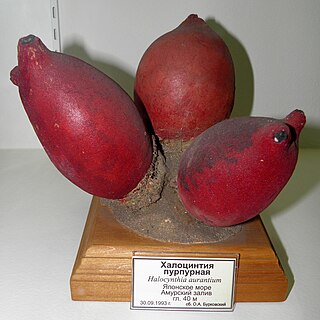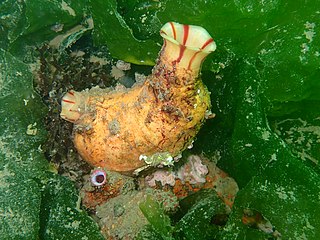
Jensen Beach is an unincorporated community and census-designated place (CDP) in Martin County, Florida, United States. The population was 12,652 at the 2020 census. It is part of the Port St. Lucie, Florida Metropolitan Statistical Area.

A tunicate is an exclusively marine invertebrate animal, a member of the subphylum Tunicata. This grouping is part of the Chordata, a phylum which includes all animals with dorsal nerve cords and notochords. The subphylum was at one time called Urochordata, and the term urochordates is still sometimes used for these animals.

The sea pineapple is an edible ascidian consumed primarily in Korea, where it is known as meongge (멍게), and to a lesser extent in Japan, where it is known as hoya (ホヤ) or maboya (マボヤ).

Halocynthia aurantium, commonly known as the sea peach, is a species of tunicate in the order Stolidobranchia. Sea peaches are commonly found in the northern Pacific Ocean, ranging from the Arctic Sea south to Puget Sound, and most common in the Bering Sea at a depth of 40 to 100 metres. The sea peach is typically barrel shaped, growing to a height of 18 centimetres, and its body is attached directly to the substrate. It is usually red or orange with a smooth or wrinkled tunic. There are two siphons at the top. The sea peach is preyed upon by crabs and sea stars.

Pyuridae is a family of tunicates.
The Bahamas is a net importer of food, importing almost 90% of its food supply. Of food imports, 80% are from the United States.

South Korea is a major center of aquaculture production, and the world's third largest producer of farmed algae as of 2020.
Spermosin is an enzyme. This enzyme catalyses the following chemical reaction

Halocyamines are antibiotic peptides isolated from the ascidian Halocynthia roretzi.
The ascidian mitochondrial code is a genetic code found in the mitochondria of Ascidia.
Colwellia meonggei is a Gram-negative, non-spore-forming aerobic and motile bacterium from the genus of Colwellia which has been isolated from the sea squirt Halocynthia roretzi from the South sea in Korea.

Neobodo are diverse protists belonging to the eukaryotic supergroup Excavata. They are Kinetoplastids in the subclass Bodonidae. They are small, free-living, heterotrophic flagellates with two flagella of unequal length used to create a propulsive current for feeding. As members of Kinetoplastids, they have an evident kinetoplast There was much confusion and debate within the class Kinetoplastid and subclass Bodonidae regarding the classification of the organism, but finally the new genera Neobodo was proposed by Keith Vickerman. Although they are one of the most common flagellates found in freshwater, they are also able to tolerate saltwater Their ability to alternate between both marine and freshwater environments in many parts of the world give them a “cosmopolitan” character. Due to their relatively microscopic size ranging between 4–12 microns, they are further distinguished as heterotrophic nanoflagellates. This small size ratio limits them as bacterivores that swim around feeding on bacteria attached to surfaces or in aggregates.
Aliiroseovarius halocynthiae is a Gram-negative and motile bacterium from the genus of Aliiroseovarius which has been isolated from the sea squirt Halocynthia roretzi from the South Sea in Korea.
Halocynthiibacter is a genus of bacteria in the family Rhodobacteraceae.
Halocynthiibacter namhaensis is a Gram-negative, rod-shaped and non-motile bacterium from the genus of Halocynthiibacter which has been isolated from the sea squirt Halocynthia roretzi from the South Sea in Korea.
Hasllibacter is a Gram-negative and aerobic genus of bacteria from the family of Rhodobacteraceae with one known species. Hasllibacter halocynthiae has been isolated from a Sea pineapple from Gangneung in Korea.
Litoreibacter halocynthiae is a Gram-negative and non-motile bacterium from the genus of Litoreibacter which has been isolated from the sea squirt Halocynthia roretzi from the South Sea in Korea.
Litoreibacter meonggei is a Gram-negative and non-motile bacterium from the genus of Litoreibacter which has been isolated from the sea squirt Halocynthia roretzi from the South Sea in Korea.

Halocynthia igaboja, commonly known as sea hedgehog, bristly tunicate or spiny sea squirt, is a species of tunicate in the family Pyuridae. It is native to the northeastern Pacific Ocean. This species was first described in 1906 by the Japanese marine biologist Asajiro Oka, who gave it the name Cynthia ritteri. It was later transferred to the genus Halocynthia.









